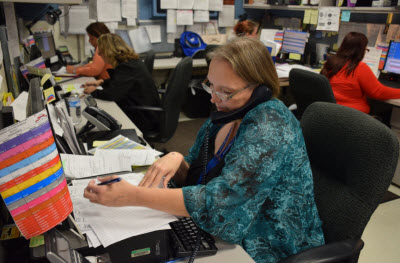-anna-green-april-mears-laurie-popovits-priscilla-boothby-renee-brown-melanie-mencacci-jennifer-almendarez-leslie-beattie.jpg?sfvrsn=a9e1d858_0)
The phones never stop ringing in UTMB’s Patient Placement Center.
Tucked away in a small office near the Emergency Department on UTMB’s Galveston Campus, the PPC is home to 12 staff members who coordinate the admission, discharge and transfer processes for all hospital patients at the Galveston and Angleton Danbury Campuses. It’s a 24 hour-a-day, seven day-a-week job.
“It’s high volume and high stress,” said Laurie Popovits, assistant director of the PPC. “Just yesterday, we had 24 people in the ED waiting for inpatient beds—and that didn’t count patients who were waiting at home, in clinic, or in the Cath Lab, Interventional Radiology or Post-Anesthesia Care Unit. There were also Intensive Care Unit patients that needed to move to a floor bed to decompress the ICUs, so that was a busy day.”
The PPC used to be known as the Bed Information Center, or BIC, until about two years ago when the name was changed to better reflect the team’s responsibilities. On an average month, more than 19,000 calls go in and out of the PPC, and staff members coordinate about 350 patient transfers in that same time frame. Transfers often come from places as near as Angleton Danbury or as far away as Belize, Ecuador and Mexico.
Leslie Beattie is a registered nurse and the transfer coordinator in the PPC. Beattie and her patient placement coordinator colleagues are expert multitaskers. It’s not unusual for staff to be talking to a physician on one phone line, holding on another, requesting a bed to be cleaned “stat” through bed-tracker software and taking down notes on a patient diagnosis all at the same time.

“No two days are ever the same,” said Beattie. “Everyone here works as a team and we take our work to heart. And we have a good rapport with our physicians. When I connect a physician from a rural area who doesn’t have the needed services for a patient, and put them on the phone with one of our doctors, it’s a great feeling. It makes everyone feel better knowing that the patient will be coming to an area where they need to be.”
If there’s an open bed, the goal is to get the patient placed within 30 minutes and reduce any delays in transferring patients from clinical intake areas such as the ED and PACU to nursing unit beds. However, it can get tricky when there’s a waiting list of admissions and the 443 beds in John Sealy Hospital are full, which is routinely the case.
“The biggest challenges are prioritization and helping others understand the urgency for bed placement,” said Popovits. “You may have six different things on your desk that you need to do including an emergency transfer, which can be a life-or-death situation, while at the same time, another six admissions just came across the printer from the ED for which you have to give team assignments and ‘page out’ the residents. What do you do first? So, it’s looking at the whole big picture and prioritizing—that’s so critical.”
With patient lives on the line, each PPC coordinator is trained for a solid three months before taking on the full responsibilities of the job independently. Popovits says there are so many different processes for each different service that it can be a lotto take in. For example, there is a 21-step process for admitting General Medicine patients, which is part of a “geolocalization” initiative to promote continuity of care by placing patients with the same team of doctors and nursing staff each time they visit the hospital.
“We go through a series of steps and look up a patient’s primary care provider and do our very best to place them on the floor with that team, so they have the same nurses, nurse practitioners and physicians every single time they come back,” said Popovits.“We started that initiative in 2014, and it’s been very popular with patients.”
Communication and collaboration with the clinical operations administrator, the administrator on call and Environmental Services are another aspect of PPC. Bed assignments are not decided just by PPC—activities and events impacting certain areas are taken into consideration.
As the new Jennie Sealy and League City hospitals open, the PPC staff will be responsible for patient placement and transfers in the new facilities,as well. And the goal will remain the same: to ensure all patients get the right bed in the right place at the right time.